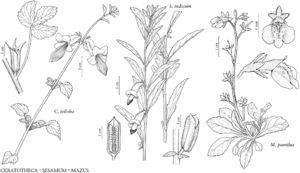Sesamum indicum
Sp. Pl. 2: 634. 1753. name conserved
Stems simple or branched proximally, 4-angled, grooved, 30–100(–150) cm. Leaves: petiole 5–12 cm; blade narrowly lanceolate to ovate, 5–20 × 1–5 cm, base cuneate, apex acute, glabrate adaxially. Pedicels 3–5 mm; bracteoles 0–2, linear. Flowers drooping; sepals 4–8 mm; corolla 2–4 cm, glandular-pubescent externally, tube slightly curved at base, mouth 10 mm diam. Capsules 15–30 × 5–7 mm. Seeds 2–3 mm, smooth. 2n = (18), 32, 52 (Asia).
Phenology: Flowering Jun–Aug.
Habitat: Disturbed sites.
Elevation: 0–1000 m.
Distribution
Introduced; Ala., Calif., Fla., Ga., La., Mass., Mo., N.J., N.Y., Ohio, Pa., S.C., Tex., Wis., origin unknown, probably s Asia (India), introduced also in South America, Europe, elsewhere in Asia, n Africa, Pacific Islands, Australia.
Discussion
Sesamum indicum is the source of sesame seeds and sesame oil. It has been in cultivation for perhaps more than 5000 years; it is difficult to determine its native range. Sesame seeds are a component of many bird seed mixes, so plants often occur near feeders. The name S. orientale Linnaeus, which pertains here, has been rejected.
Selected References
None.
